Quality of the Environment in Japan 1993
b. Approaches by Businesses
Private businesses in developed countries invest in developing countries, and many of them engage in economic activities there, too. When environmental issues in developing countries are taken into account, therefore, the activities of those private businesses is of impor- tance. It is pointed out that what they are exporting sometimes is pollution to developing countries, on the one hand, and hopes are pinned on them as those who transfer technology for the prevention of pollu- tion.
According to a survey conducted by the Environment Agency on Japanese businesses in Indonesia (see 2, Section 2, Chapter 4), 61% of them adopted the local standards as their target for environmental measures, whereas 13.4% used the Japanese standards and 13.4% employ standards of their own which are severer than the local stan- dards. Those findings suggest that the local standards were generally used as their target and not so many businesses made approaches of their own (Fig. 4-1-45).
Fig. 4-1-45 Level of Environmental Measures
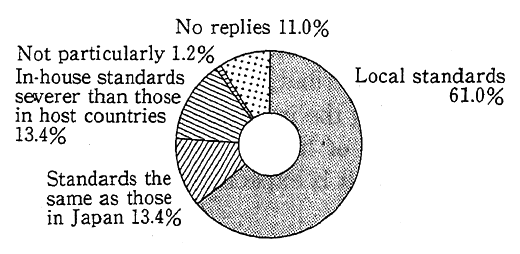
Source: Surveyed by the Environment Agency
In another survey, it was replied about barriers to local environ- mental problems that there was a lack of local specialists and techni- cians engaged in environmental measures (39.7%), that the standards which ought to be abided by were vague and the industries associated environmental measures have yet to be developed (25.8%), that it was difficult to procure equipment and materials necessary for environmen- tal measures (7.8%) and the environment-related legal institutions were inadequate (3-8%). Those answers suggest that businesses accept the imperfection of institutions for the exercise of environmental controls, such as the ambiguity of standards which serve as the basis for the promotion of environmental measures in the developing countries, and the lack of manpower, equipment and materials, among others, as barriers to approaches to environmental measures.
When it comes to approaches to environmental issues, the rates of Japanese businesses which thought they were promoting environmen- tal measures to the same extent as, businesses from other developed countries and local businesses suggest that the responses made by local businesses were not developed in a relative term, as in smoothly carry- ing out environmental measures, 27.9% of Japanese businesses thought they were better than those from other developed countries, 35.4% thought they were better than those from countries other than devel- oped countries and 54.9% think they were better than local businesses (Table 4-1-12). It may be discerned that medium and small businesses with local capital and businesses with outdated facilities are not fully taking environmental measures in terms of capital and technology. On the other hand, businesses from developed countries have funds and technology, so that it might be taken that they are also sensitive about the criticism for "pollution exports."
Table 4-1-12 Businesses and Environmental Problems in Developing Countries
Did environmental issues crop up in locating plant facilities?
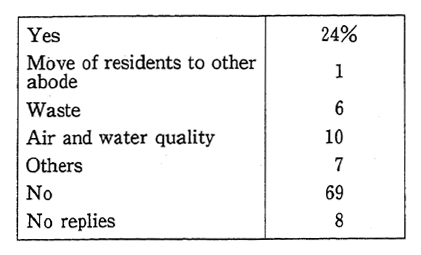
Are other corporations carrying out environmental measures in a smoother manner than your firm?
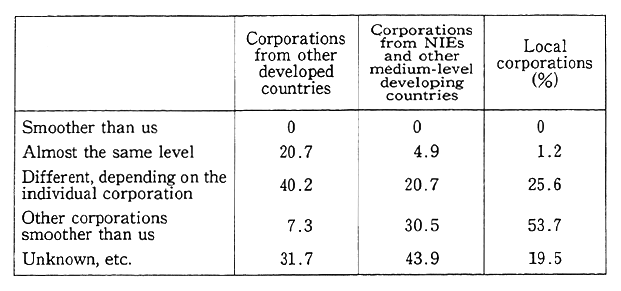
Source: Surveyed by the Environment Agency
As many as 42.7% of Japanese businesses abroad were concerned about their possible involvement in troubles over local environmental issues in the future. There are signs that controls on the water quality, in particular, will be reinforced in developing countries at a fast pace, and it might be taken that there is concern about how to respond to that trend. As regards the merits in environmental terms of the businesses in developing countries, on the other hand, it came to light that 34.1% of Japanese businesses abroad thought that they were instrumental in upgrading technology and nourishing ability for environmental conser- vation in developing countries, and that 45D1 % thought they would be of help in the future. In terms of technology and funding, foreign businesses are of more advantage than local businesses in stepping up environmen- tal measures. For foreign businesses in developing countries, now is the chance to take the lead in private businesses' environmental measures by promptly responding to environmental issues while controls are strengthened.
(3) Support to Developing Countries for Self-reliance
As we have seen at the outset, environmental conservation in developing countries is something with which the world has to wrestle. As we have mentioned in (2), above, it is important for residents in developing countries to recognize the importance of protecting the environment and appropriately manage it by themselves.
In order that developed countries may cooperate in solving the environmental issues posed for developing countries, it is important to support the self-help of developing countries. Human development and capacity building by administrative authorities and other organizations will presumably contribute to the solution of environmental issues in developing countries in the long run.
Japan has also given grants to the Environmental Research and Training Center in Thailand, the Sino-Japanese Friendship Environ. mental Conservation Center in China and the Environmental Manage- ment Center in Indonesia and technical cooperation for human develop- ment, and there is the need to steadily carry on such cooperation.
There are many cases in which businesses offer training as a means of cooperation for human building.
Increasingly brisk are the activities of nongovernmental organi- zations (NGO) which support local people who work for the environ- ment, while enhancing their consciousness of the environment. As NGOs are in direct contact with local people, it is possible to absorb their needs and step up measures, while deepening the understanding about local environmental issues and measures along with them, paving the way for locally-oriented cooperation. To support such activities, small- scale gratuitous fund cooperation, volunteers' savings and the NGO grant-in-aid system by the Ministry of Foreign Affairs, Ministry of Agriculture, Forestry and Fisheries and Ministry of Posts and Telecom- munications are in force. The Bill for Amendments to the Law for the Japan Environmental Corporation has been submitted to the Diet to enable the corporation to support environment-related NGO activities, among other things.
In the final analysis, it is the people who has to wrestle with environmental issues by the sweat of their brow. In order to enable them to do their best, it might be said that even people who are living away from places where environmental issues are posed have a commensurate role.
4-2 Toward Realization of Coexistence with Environment
As we have seen in Section 1, we are confronted with a wide variety of problems in maintaining a good environment at regional and global levels. It is difficult to solve any of them in a brief span of time. Many of them are not something which could be solved by controlling specific persons. In trying to solve those questions, it is required to tenaciously cope with them while various entities which form society cooperate through an appropriate apportionment of roles. In other words, various entities different in position in the economic society should take another look at their erstwhile relations with others and rebuild them into better ones. In the following, let us see on the basis of new environmental responsibilities we have seen in Chapter 2 how entities are expected to give a second look at their relations with others.
4-2-1 The People
As we have observed in Section 1, Chapter 2, national consump- tion accounts for about 56% of the gross national expenditure. When industrial investments induced by national consumption and so forth are included, the impacts it produces on Japan's economic society will be far greater. The greater the dimensions of the people's activities, the greater the impact on the environment. For example, the life of each one of the people constitutes a cause of environmental issues, as is discern- ible from pollution of an urban and household type and from global warming. This is what we have seen in Section 1, Chapter 2. In light of this, it has become important for the people to make positive efforts, such as by making the life style itself tender toward the environment.
In Agenda 21 adopted at the Earth Summit, emphasis was put on the importance of the roles played not only by the national and local governments but by the people and their organizations for conservation of the global environment. Here, let us think about the present state of the people's roles and approaches and take a look at the citizens' grass-roots movements in which the people engage while cooperating with one another or foreigners.
(1) The People's Consciousness of, and Acts for, Environmental Conservation
There is a rising consciousness about the environment with concern about worsening. A check of the opinion poll made by the Prime Minister's Office in February 1993 reveals that the people have taken increasingly higher interest primarily in problems which arise out of life, such as household effluents, and those on the global environment than in air and,water pollution by factories (Fig. 4-2-1). A broad segment of the people have come aware of the fact that problems on the global environment are closely tied in with their own lives (Fig. 4-2-2).
Such conceptual changes, are reflected in the people's behavior, and the number people who pay heed to environmental conservation in their everyday lives has exceeded 90% (Fig. 4-2-3). As an example, about 17% of respondents said that they had purchased Eco Mark merchan- dise, (Fig. 4-2-4). Even in the phase where routine merchandise is used and thrown away, contrivances and efforts are made, such as efforts to refrain from washing out frying oil and so forth from drainage outlets, to minimize the discard of trash, to work for the saving of electric power and tap water and to do recycling and selective collection (Fig. 4-2-5). It might be said that the people's consciousness has come up to a level where they actually take action for reductions in environmental loads by themselves.
Fig. 4-2-1 Interest in Environmental Issues
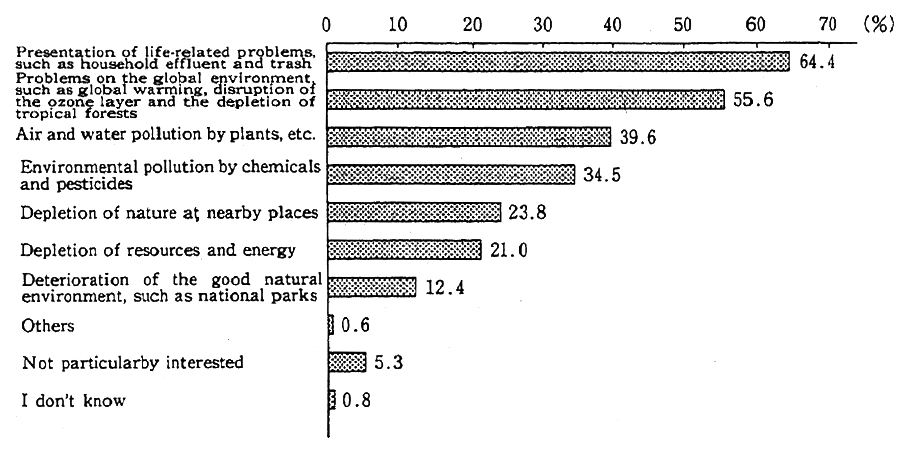
Note: The total number of respondents is 3,754.
Source: Prime Minister's Office, Opinion Koll on Environmental Conservation, 1993
Fig. 4-2-2 'Problems the Causes of Which I Think Are Closely Tied in With My Own Life'
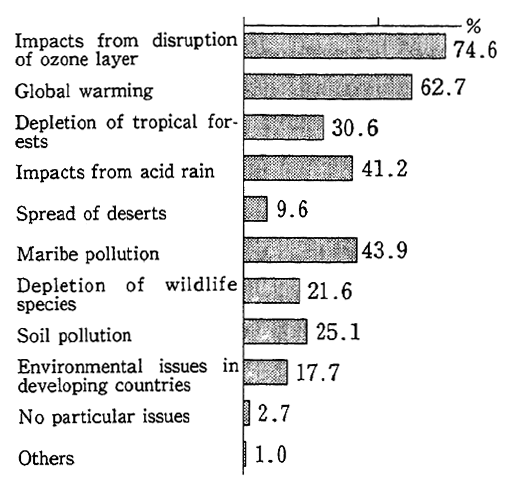
Note: The total number of respondents is 1,372.
Source: Environment Agency Monitors' Questionnalire Survey, 1990
Fig. 4-2-3 Attention to, and Concrete Action for, Environmental Conservation in Everyday Life

Note: The total number of respondents in 958.
Source: Tokyo Metropolitan Governmentdesignated Monitors' Questionnaire Survey on Consumer Life, 1991
Fig. 4-2-4 Degree of Knowing About Eco-Mark

Note: The total number of respondents in 3,754.
Source: Prime Minister's Office, Opinion Poll on Environmental Conservation, 1993
Fig. 4-2-5 Ideas and Efforts for Environmental Conservation
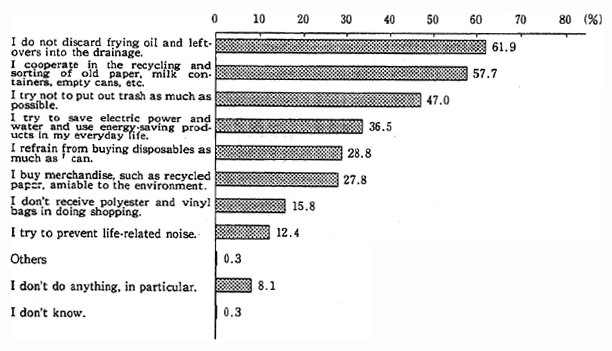
Note: The total number of respondents in 3,754.
Source: Prime Minister's Office, Opinion Poll on Environmental Conservation, 1993
In the Bill for the Basic Environmental Law presented to the Diet in March 1993, the people's responsibilities for the environment are expressly defined with attention paid to causative factors and the rising consciousness of the people. The bill takes it up as a basic ideal "to reduce as much as possible the environmental loads produced by socio- economic and other activities and to voluntarily and positively carry out other activities for environmental conservation with the roles of all persons impartially apportioned." It is also stipulated that "it is up to the people to strive for reductions in environmental loads in their everyday lives for the prevention of hindrances to environmental conser- vation" and that the people are obligated "to strive of their own accord for environmental conservation in line with the basic ideal and to cooperate in the measures taken by the State or local governments for environmental conservation."
a. Deterrents to Voluntary Efforts for Environmental Conservation
The people are expected to share roles and voluntarily and positively strive for environmental conservation. There are a number of barriers to people's efforts. According to a survey of the Environment Agency, for example, 40% of the respondents had the intention of starting environmental conservation activities, but barriers arose in the sense that they had no information about what could be done or did not have time, support or money to participate--that is to say, the situation is that activities are not so positively stepped up as the rising conscious- ness (Fig. 4-2-6). The opinion poll conducted by the Japan Broadcasting Corporation (NHK) on the time set aside for leisure indicates that the length of time allocated for a wide variety of social activities is merely 23 minutes on the average even on Sundays.
Fig. 4-2-6 Impediments to Activities for Environmental Conservation
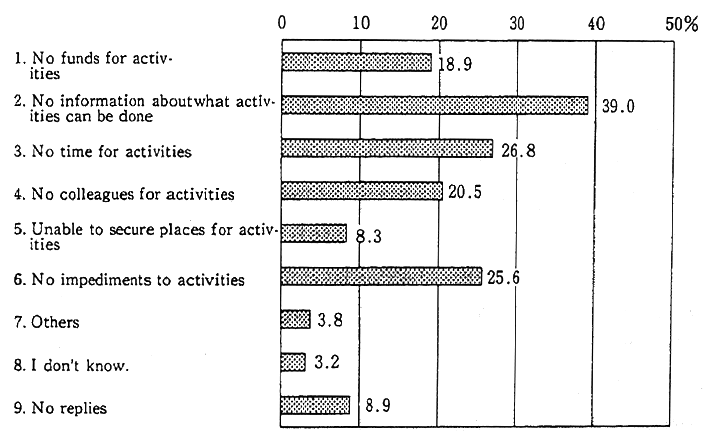
Note: The total number of respondents in 1,231.
Source: Environment Agency-designated Monitors' Questionnaire Survey, 1992
b. Approaches by Government, Etc.
The central and local governments or businesses have embarked upon a wide variety of measures so that difficulties and barriers may be overcome and environmental conservation may be stepped up in a more efficient manner with the involvement and cooperation of a broader segment of the people.
The government plans to support the training of interpreters as persons who will promote activities for communion with nature and formulate a guideline for local governments in offering residents chances to learn about the environment. It also supports national land greening and other movements. For the promotion of local environmen- tal conservation activities, the government has established a Local Environmental Conservation Fund in each prefecture, suppporting the preparation of textbooks, the execution of events for propagation and enhancement, and the implementation of other projects.
Among businesses, there are moves to provide employees with paid leave when they are to involve themselves in activities contributory to society and establish and support an on-leave system for volunteers (Fig. 4-2-7). In response to such corporate moves, the Federation of Economic Organizations (Keidanren), for one, incorporates it as one of the corporate environmental conservation activities in the Global Envi- ronment Charter for employees to involve themselves in environmental conservation activities so that they may become "good corporate citi- zens." Thus, it has become a practice to support a wide variety of entities so that they may step up their environmental conservation activities. In the aforementioned Bill for the Basic Environmental Law, measures for the promotion of education and learning about environ- mental conservation, among others, and of voluntary activities by citizens' groups and so forth are clearly defined to further step up approaches by each segment of the people. It is to be hoped that those measures will be further replenished and reinforced in the future.
Fig. 4-2-7 Corporate Support to Volunteer Activities by Employees (Present and Future)
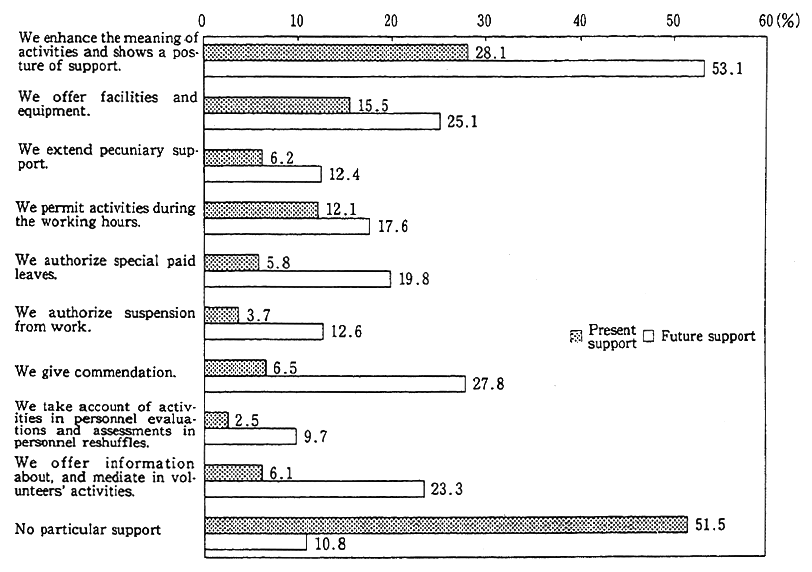
Note: The total number of respondents in 1,164 (duplicated replies).
Surce: Surveyed by Sumitomo Life Insurance's General Research Institute (1991)
(2) Difficulties for Citizens' Groups for Environmental Conservation
A review of the activities of citizens' groups in Japan for environ- mental conservation indicates that nature protection activities were evolved already in the early period of the Showa Era (1926-89). The Wild Bird Society of Japan, which is the largest of all citizens' environmental groups in Japan today, came into being in 1934, whereas the Nature Conservation Society of Japan was founded in 1951. In the subsequent period during which time Japan made remarkable economic progress, there were increasingly brisk activities in support of the rights of sufferers from industrial pollution, calling forth reactions from the people.
When pollution of an urban and household type, such as problems about effluents and garbage, had come to the fore, it became a practice to develop citizens' activities of a "practice and proposition" type in attempts to take another look at their own life style. With a rising consciousness about problems about the global environment in recent years, the scale of activities became international and the number of nongovernmental organizations (NGO) which evolve activities in a global perspective began to increase. In the 1980s, on the other hand, the NGO activities began to assist the development efforts of developing countries encompass environmental issues.
Activities by citizens' environmental groups are significant, as they create talented people through their activities and enhance the consciousness of a broad segment of the people. Then there are cases in which citizens devote themselves to environmental conservation activ- ities in developing countries as "global citizens." International assis- tance by such philanthropic organizations makes it possible to directly carry out projects closely tied with the community at a grass-roots level, and evolve activities in sectors which cannot be covered by the State and local governments. As they have begun to extend trans- boundary mutual assistance in wrestling with environmental issues, citizens are compelled to develop a new form of cooperative relations. In the following, let us take up international cooperation, the most difficult one for citizens to form, and think about ways of promoting it.
The first difficulty citizens' environmental groups have is a shortage of money. Actual assistance in various international coopera- tion, to say the least of environmental conservation activities in develop- ing countries by -citizens' organizations, accounts for only 1.9% of the total amount of official development assistance (ODA), or $1.4 per capita. In either case, Japan is behind developed countries, and it it a task to expand it (Fig. 4-2-8).
Fig. 4-2-8 Rate of NGO Aid to Real Per Capita NGO Aid in DAC ODA in DAC Countries Countries

Source: DAG
Thus, international environmental cooperation by citizens' groups, has not necessarily grown in quantitative terms, when compared with those of other countries. The surveys made on citizens' environ- mental groups include a questionnaire survey made by the Environment Agency on 661 organizations in 1992. The findings show that nearly 70% of those organizations do not have a paid full-time staff, and the groups which engaged in international activities with a staff of more than 20 paid members (groups of an international type) accounted for only 20% or so. In terms of annual budgets, groups with a yearly budget of less than ¥1 million accounted for as many as 60%, roughly half of them surviving on less than ¥50 million a year (Fig. 4-2-9). In contrast, partly because they are different from those in Japan and their history is long, nongovernmental organizations in Western countries, some environmen- tal groups have an annual budget of more than ¥1O billion and a membership of several millions of people (Fig. 4-2-10). Public-good organizations in Japan are described as having a smaller membership and being more fragile in financial terms than those in Western coun- tries, and citizens' environmental groups in Japan are no exception. Fig. 4-2-9 Budget and Scale of Citizens' Environmental Groups in Japan
(1) Fverage annual budget
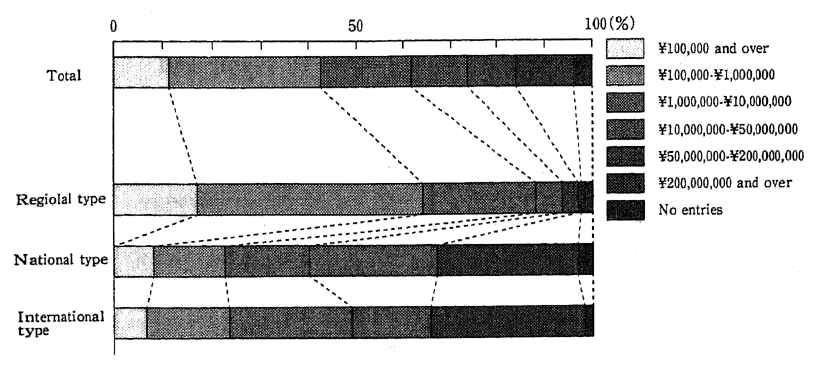
(2) Number of paid regular staff members
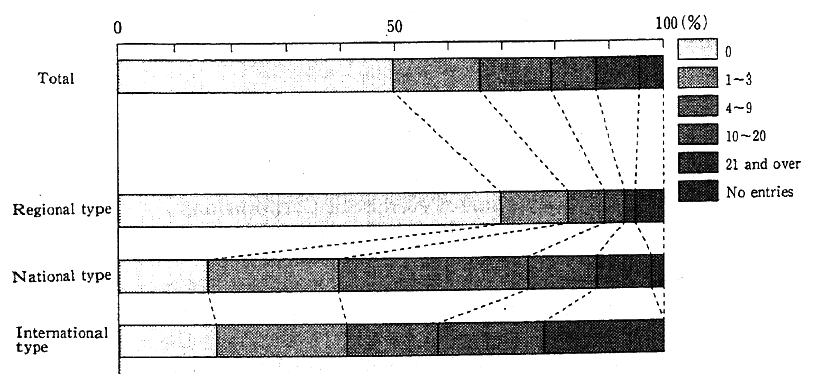
Notes: 1. Surveyed by the Environment Agency
2. The total number of responding organizations is 386, including 238 organizations of the regional type (Which do activities in some part of Japan), 73 organizations of the national type (Which do activities all over Japan) and 75 organizations of the international type (Which do activities both at home and abroad).
Fig. 4-2-10 Scale of Foundations in Japan and the United States
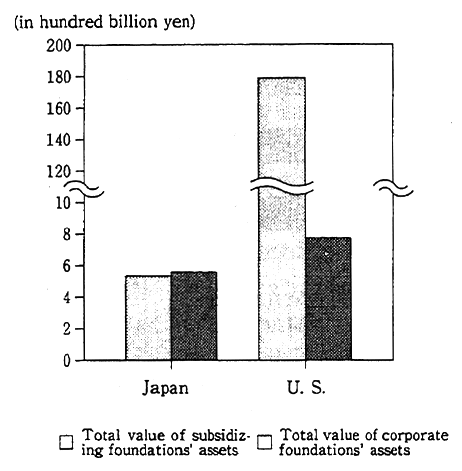
Source: Surveyed by the Foundation Data Center and the Association of Nonprofit Corporations; National Data Book of Foundations, 16th edition, 1992
Note: The numcer of subsidizing foundations is 394 in Japan and 32,401 in the United States, and that of corporate foundations is 460 and 1,718 in the United States. The number of corporate foundations in Japan is based on the questionnaire survey conducted by the Association of Nonprofit Foundations in 1991.
Many private philanthropic organizations, such as citizens' groups, complain about a lack of money, because there is historically a lack of tradition of giving donations for social contributions, so there is a lack of understanding on the part of the people, and because there has been a lack of dialogue between segments of the people, administrative authorities and industry, among others. In Japan, the total amount of donations made by individual taxpayers was ¥36.6 billion (in fiscal 1991), whereas the donations made by businesses were ¥563.4 billion (in fiscal 1991 according to a survey of the National Tax Agency) (Fig. 4-2-11). Nearly 60% of the reasons businesses had in mind when they made donations were demands from other firms (Fig. 4-2-12), suggesting that the donations were not made in their own judgment. On the other hand, let us take a look at the United States as an example. It is said that there is social environment in which donations can be easily collected because of a long tradition of charity projects and social contributions. The total amount of donations by individuals came to $101.8 billion (¥12,400 billion) and that of donations by bodies corpora- tions reached $5.9 billion (¥700 billion); both figures are cited from the AAFRC's Giving USA 1991.
Fig. 4-2-11 Contributions by Corporations (FY 1990)
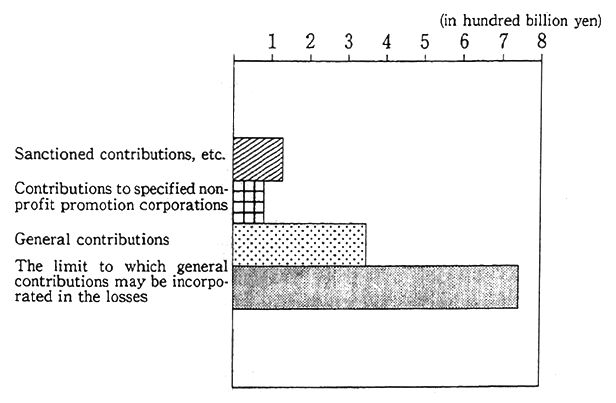
Sorces: Additions are made to what is carried in the May 1992 issue Gekkan Koeki Hojin (Monthly Nonprofit Corporations) on the basis of the National Tax Agency's Report of the Findings of the Sampling Survey of Companies.
Notes: 1. The sanctioned contributions as referred to here are the contributions made to the State, local governments, etc., and those sanctioned by the Minister of Finance as having a distinct character of being made for public good, and their total amount may be incorporated in the losses without relevance to the limit to which they may be incorporated in the losses.
2. Contributions to specified nonprofit promotion corporations my be incorporated in the losses to the amount which is twice as much as general contributions.
3. The limit to which contributions may be incorporated in the losses are the estimate computed from the amounts of capital and incomes of all corporations.
Fig. 4-2-12 Reasons Given by Japanese Businesses for Activities Contributory to Society
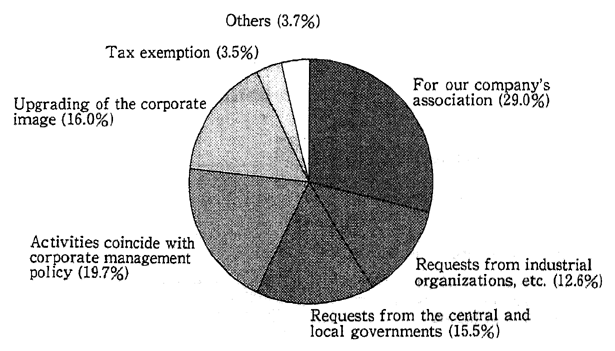
Note: Additions are made to what is prepared by the Bank of Japan on the basis of the questionnaire survey done by the Federation of Economic Organizations (Keidanren) in November 1989.
Beside funding, citizens' environmental groups have many other problems. Among them, it cannot be said that there is a lack of efforts on their part, or that the methods employed by them have yet to be developed. For improvements, they are expected to make self-help efforts. Besides, a little more than 40% of the organizations in the aforementioned survey to citizens' groups on problems they had replied that they did not have full "information." And they said that there was particularly a lack of "information about means and methods for environmental conservation activities." Nearly 60% felt that there was a lack of manpower. Moreover, there is a shortage of information and manpower necessary for practical activities, to say the least of funding, and it might be said that those elements deter their activities (Fig. 4-2-13).
Fig. 4-2-13 Problems Posed for Citizens' Environmental Groups
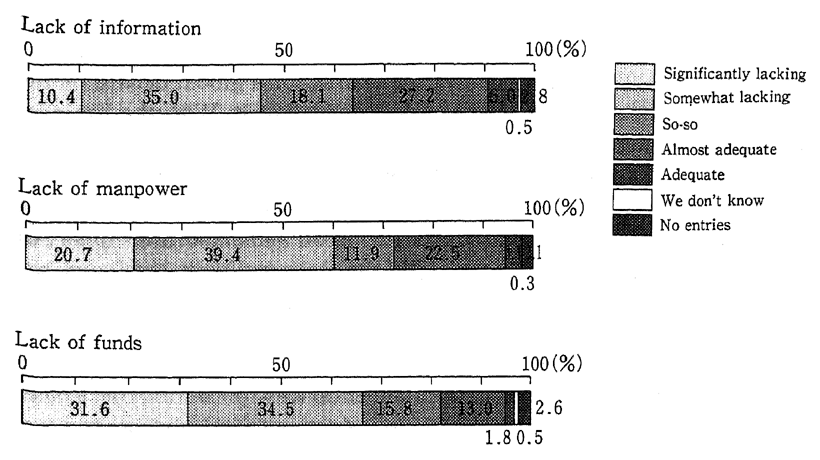
Note: Surveyed by the Environment Agency. The total number of responding groups is 386.
(3) Support to Citizens' Environmental Groups
As the notion that citizens' voluntary activities must be sustained with a growing interest in issues on the global environment, the govern- ment has begun subsidization and so on for their activities. When it comes to environmental conservation activities in developing countries, the Ministry of Foreign Affairs established in fiscal 1989 an NGO subsidization system for citizens' organizations useful for an enhance- ment of residents' welfare. Besides, the Ministry of Posts and Telecom- munications began an aid project in the International Volunteer Savings system in fiscal 1991. Nonetheless, as those mechanisms are so broad in terms of subsidization that they are not confined to environmental conservation, thus being no longer able to respond to an expansion and diversification of the needs of citizens' environmental groups.
Given this backdrop, the Bill for Revision of the Japan Environ- ment Association Law was presented to the 126th Session of the Diet in February 1993 to establish a Global Environment Fund in the Japan Environment Association so that the government and the private sector in Japan may makeconcerted efforts to support activities for conserva- tion of the global environment by citizens' groups. The notion of support to international environmental cooperation at citizens' level with a combination of governmental and nongovernmental efforts was introduced at the Earth Summit held in June 1992 and also at the Eminent Persons' Meeting on Financing Global Environment and Devel- opment, which was held in Tokyo in April of the same year in prepara- tion for the Earth Summit and set the course for a global debate on the funding of efforts to protect the global environment. With the Eminent Persons' Meeting on Financing Global Environment and Development as momentum, the proposed Global Environment Fund was studied and came into being with a revision of the Japan Environment Association Law. In the fund, plans are afoot for the broad and elaborate support of citizens' environmental groups with the corporation's own surveys, researches, offer of information and training, among others, necessary for the practical activities of citizens' environmental groups, to say the least of support for their practical activities in developing countries.
In the Bill for the Basic Environmental Law presented to the Diet in March 1993, the importance of voluntary activities by nongovern- mental organizations and so on for the promotion of international cooperation in conservation of the global environment, among others, is made clear, and it is stipulated that information and other necessary measure shall be made available for promotion of those activities. It is expected that with the involvement and coordination of a broad seg- ment of the people, including businesses, this fund will be replenished as a long-term and uninterrupted system of support for the international cooperation activities of citizens' environmental groups, and interna- tional cooperation of which citizens' environmental groups take charge will become all the better. Better results from the activities of citizens' environmental organizations will promote charity and take root in the national life and Japanese society morally enhance itself.
4-2-2 Businesses
When we take a look at each sector of the national economy, as we have seen in Section 2, Chapter 2, the impacts produced by the manufacturing sector are not insignificant by any means. Enterprises which primarily take charge of the manufacturing sectors are expected to contribute to the building of a sustainable society with less environ- mental loads. Here, let us take a look at the present state of businesses' approaches to environmental conservation, including the conditions which hamper the efforts
(1) Differences of Businesses' Approaches to Environment Between Past and Present
It is in the 1965-74 period, when industrial pollution began to be taken into account, many businesses in Japan began to wrestle with measures against environmental pollution on a full scale. During that period, society kept a strict eye on aggravating industrial pollution and the social responsibility of enterprises was called to account. In the latter half of that period, businesses' expenditure for investments in facilities for the prevention of pollution began to rise at a fast pace (Fig. 4-2-14). In 1967, the government enacted the Basic Law for Environmen- tal Pollution Control to define entrepreneurs' obligations for the preven- tion of pollution and streamline a wide variety of pollution-related laws and ordinances. Besides, it also enacted the Law for Establishment of Organizations for Pollution Control in Specified Factories in June 1971. In July of the same year, the Environment Agency was established to start preparing and enforcing plans for environmental controls and step up the streamlining of institutions with the cooperation of both govern- mental and private sectors. With responsibilities clarified and institu- tions developed, rampant industrial pollution was gradually alleviated, and corporate environmental control measures began to take root.
Fig. 4-2-14 Trends in Environmental Conservation-related Corporate Expenditure
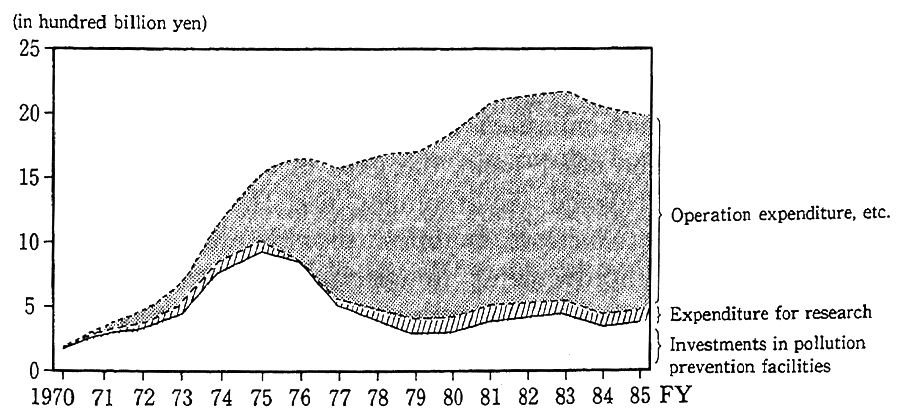
Notes:
1. Prepared by the Environment Agency on the basis of the Survey on Trends in Investments in Pollution Prevention Facilities by the Ministry of International Trade and Industry and the Survey on Scientific and Technological Researches by the Management and Coordination Agency
2. The operation expenditure, etc., as referred tohere, include the expenses for electric power, chemicals, manpower, parts and so forth for the operation of pollution prevention facilities. For their projection, the OECD's example is followed, this expenditure represents 20% of what is gained by expressing in terms of the subject fiscal year's prices the aggregate amount of investments made in pollution prevention facilities (pollution prevention facilities in stock) till the preceding fiscal year. Here, it is assumed that pollution prevention facilities fine renewed every 12 eyars.
In recent years, however, it has become a practice to call on businesses to make approaches different from conventional environmen- tal control measures, as we are confronted with questions about the global environment and those on environmental pollution of the urban and household type. When it comes to conventional industrial pollution, it was made a clear target to protect the health of residents around factories and what had to be done for their health was technically clear, as substances hazardous to health came out in the production process and went into the neighboring environment through smoke stacks and drainage outlets. As regards the degree to which environmental control measures had to be implemented. the rule was, for example, to abide by demands from outside the corporation, such as emission standards based on laws and ordinances and agreements for the prevention of environ- mental pollution in the areas where factories were located. As regards curbs on carbon dioxide emissions as a principal causative factor for global warming, on the other hand, the goal is to protect the future generation's--and worldwide--environment, and though there are in- numerable means for reductions in carbon dioxide emissions, decisive means are lacking improvements in specific production processes. Therefore, there are calls for the merging of all-company responses into a system. As for the degree to which measures have to be taken, the goal is set for reductions in carbon dioxide emissions in Japan, but concrete corporate measures are left to the discretion of individual businesses. Given the mounting interest in the global environment, on the other hand, the people's attention is focused on businesses and the implemen- tation of measures turns out to be something which cannot be sideste- pped.
(2) Substance of Corporation Activities Amiable to Environment
Table 4-2-1 Actions Specified in Global Environment Charter of Federation of Economic Organizations (Keidanren)
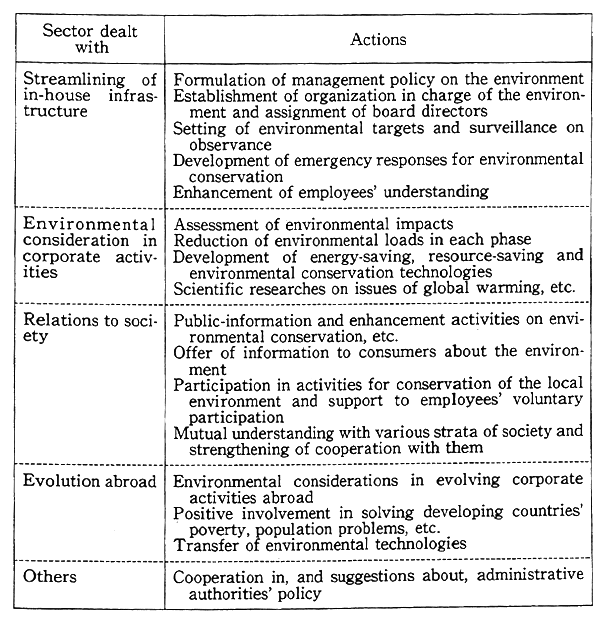
Note: Prepared on the basis of the Global Environment Charter of the Federation of Economic Organizations (Keidanren)
Given all those developments, businesses, compelled to come out with approaches of their own, have come to evolve a wide variety of measures. On how those measures look the Global Environment Charter formulated by the Federation of Economic Organizations (Keidanren) in April 1991, for example, may serve as a reference. The charter encour- ages businesses to seriously deal with environmental issues for the building of a new socioeconomic system for realization of society of an environmental conservation type in which sustainable development is possible. The approaches recommended to member corporations are broad and diverse as shown in Table 4-2-1. On the way those approaches were made, the Environment Agency surveyed firms registered with the first and second sections of stock exchanges in 1992 (the Second Survey on Corporate Activities Amiable to the Environment), and some of the findings follow. First, a type-specific check of those lines of business in which the environment was taken into account, about 78% of the corporations took account of the environment in their regular lines of business, and about 66% paid some form of environmental consideration or the other in the lines of business associated with disposal. When it comes to the lines of business tied in with the collection of reSources, which might be described as an "upstream" corporate activity, only about 13% of the corporations made responses partly because there were few businesses which were directly associated with the collection of reSources (Fig. 4-2-15).
Fig. 4-2-15 Phases Where Corporate Actions Amiable to the Environment Are Taken

Notes: 1. surveyed by the Environment Agency
2. The total number of responding corporations in 528
The corporate expenditure for environmental conservation (not the amount of investments but the annual expenditure; the scope is different, though, depending on the corporation) averaged 0.7% of the proceeds in the manufacturing industry, and there were many businesses which did not tabulate expenses for the environment.
(3) Organization for Environmental Conservation
The work done by businesses for environmental conservation has become complex and massive, not only because it has become massive in volume but because each in-house corporate organization takes account of the environment in the line of business of which it takes charge. Given this factor, businesses are setting up in-house organiza- tions in charge of environmental conservation.
According to the aforementioned questionnaire survey of the Environment Agency, many corporations began to establish a division in charge of environmental conservation in 1990, when problems on the global environment came to draw public attention. In the manufacturing industry where in-house divisions in charge of environmental conserva- tion were already established in the latter half of the 1965-74, there were many cases in which they were reorganized into ones which would take charge of not just pollution problems but all aspects of environmental issues, including those on the global environment (Fig. 4-2-16). In indus- tries other than the secondary industry, the corporate activities of which produce great environmental loads, an increasing number of businesses are coming out with a division in charge of environmental conservation.
Fig. 4-2-16 Year of Establishment of Posts in Charge of Environment and Scope of Work
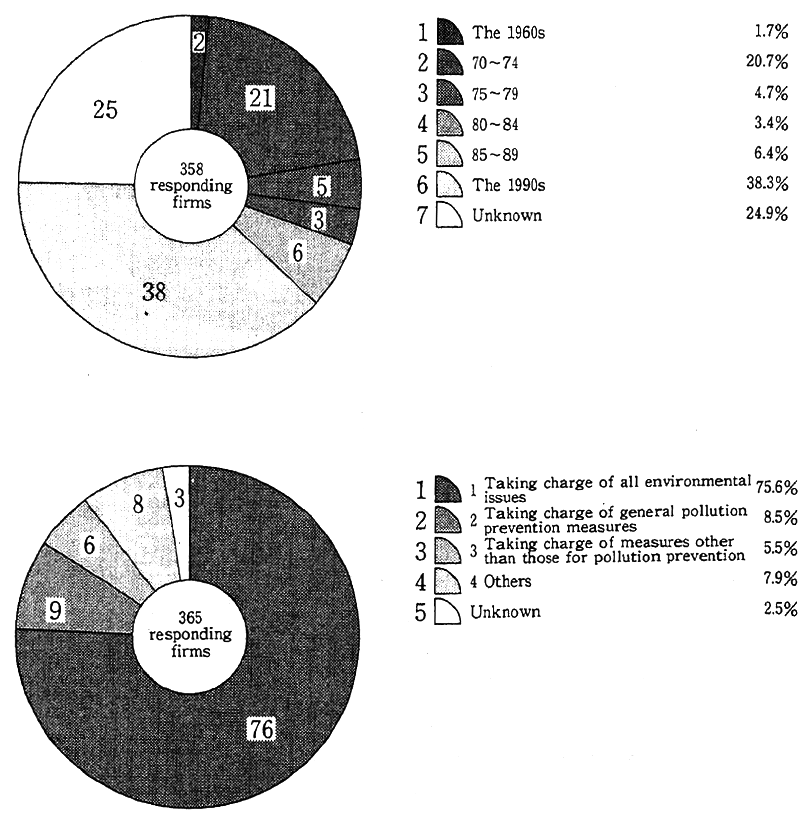
Note: Surveyed by the Environment agency
In the following, let us examine the roles played by those divi- sions.
a. Relations Between Environmental Control Measures and Corporate Targets
For businesses, in particular, environmental measures are not something which produces immediate profits and their burdens are not small in the ongoing recession. In order to take actions in this rigid circumstance with consideration paid to the environment, it is important to incorporate environmental conservation in the targets individual businesses are to achieve or establish a specific management policy on the environment. According to the findings of the aforementioned questionnaire survey, 34% of the corporations formulated an environ- mental policy, and in the manufacturing industry alone, nearly half, or 45%, formulated some policy or the other (Fig. 4-2-17). Also according to this survey, there were many cases where those policies were worked out, or their ingredients were determined, by a division in charge of the environment.
Fig. 4-2-17 Existence/Monexistence of Management Policy on Environment

Note: Surveyed by the Environment Agency
b. Position of In-house Division in Charge of Environment in Businesses
A check of the status of divisions in charge of the environment in businesses, to the questionnaire reveals that more than 50% of the corporations made it an "organ directly under the president," "part of the coordination and control sector" or "part of the planning sector." Then, 17% made the division function as part of organizational line or the manufacturing or business sector (Fig. 4-2-18). Thus, there are many cases in which the division is made part of the head office's organiza- tion. It might be said, therefore, that there also are many cases in which the division, acting as a staff, oversees in-house environmental control measures, including those taken by the production line. When it comes to the director of the division in charge of the environment, the director- ship is assumed by board directors, including the president and the board chairman, in about two-thirds of the corporations. Having said that, it is conceivable that environmental conservation is made some- thing which has to be done by all sectors of the company or at the top management level.
Fig. 4-2-18 In-house Status of Division in Charge of Environment
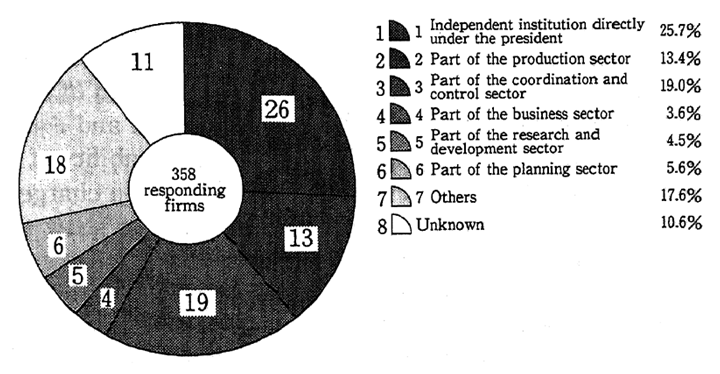
Note: Surveyed by the Environment Agency
In terms of organizational dimensions, however, more than half of the corporations assign less than 10 officials as full-time staff members of the division in charge of the environment, so much so that the division cannot be considered a big in-house unit (Fig. 4-2-19).
Fig. 4-2-19 Number of Full-time Staff Officials in Division in Charge of Environment
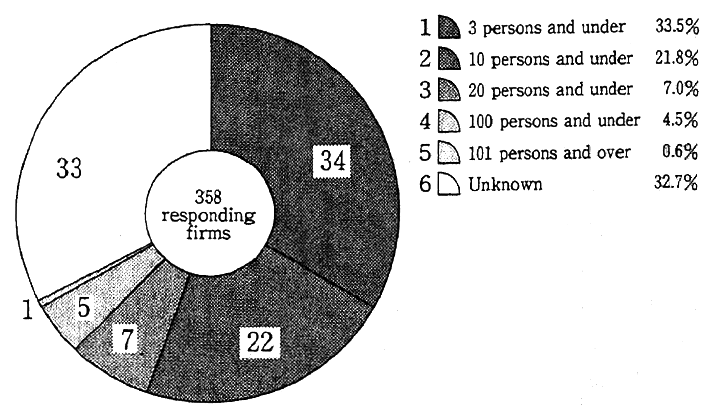
Note: Surveyed by the Environment Agency
c. Involvement of Division in Charge of Environment in Corporate Decision-making
A check of how influential the division in charge of the environ- ment is over in-house decision-making reveals that only 26% replied the division had some influence or the other over policy which encompassed all aspects of corporate management and the formulation of long-term programs. When it comes to decisions on major plant and equipment, the formation of annual production plans and the advisability of putting out new products, the findings show that the division in charge of the environment did not have much influence. The findings show that the items over which the division had much influence were confined to directly environment-related items, such as decisions on budgets for environmental conservation and checks on the implementation of envi- ronmental control measures (Fig. 4-2-20). Then there are businesses in which the division's agreement is indispensable when investment is to be made in plant and equipment, though this requirement did not appear in the questionnaire survey. It might be said that the involvement of the division in charge of the environment is in the process of expansion and change.
Fig. 4-2-20 Impacts of Division in Charge of Environment
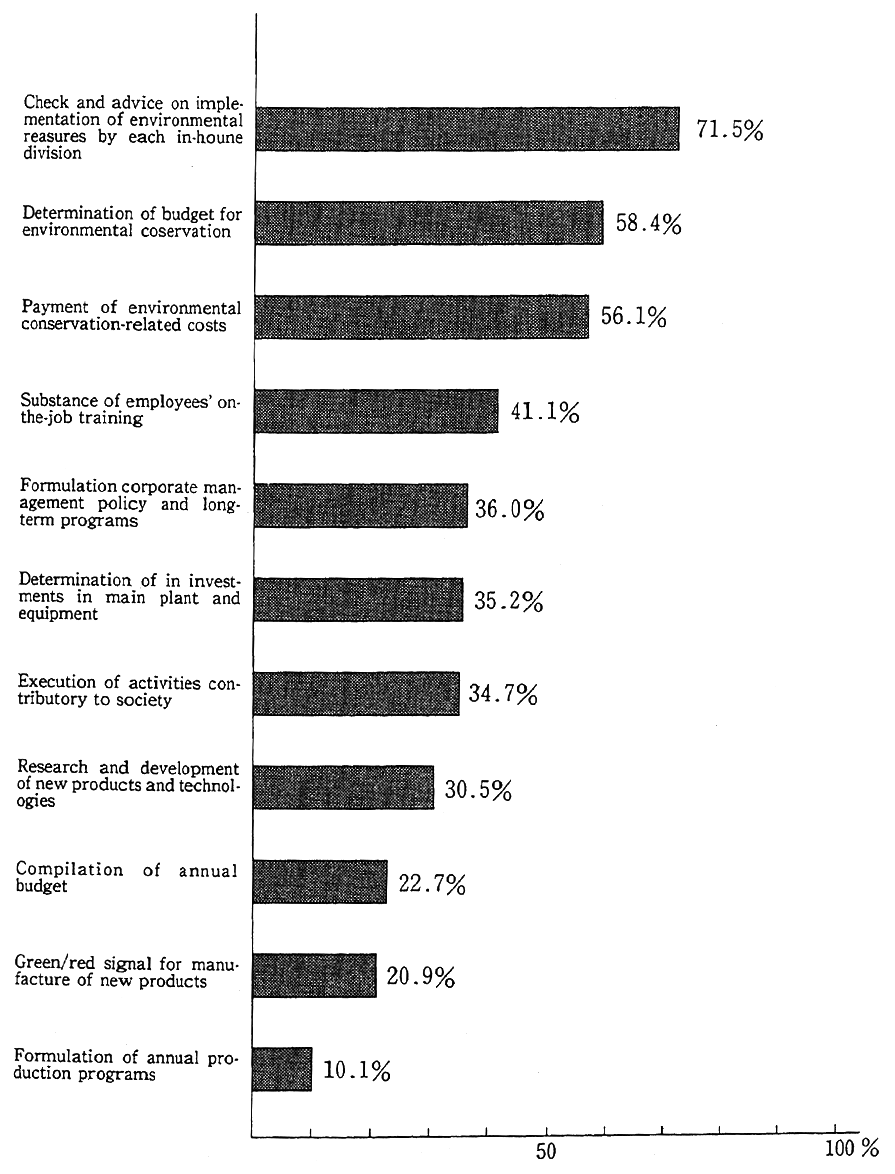
Notes:
1. Surveyed by the Environment Agency
2. The rates are those of corporations which have replied that the division in charge of the environment has a "considerable impact" or "certain impact" in regard to the above items. The total number of responding firms is 358.
d. Coordination Between Division in Charge of Environment and Other Divisions
When it comes to non-profit making activities, such as environ- mental controls measures, a divergence of opinion will possibly arise between the division in charge of the environment and other divisions, so that for decision-making in such eventualities, it is necessary to prepare a framework of coordination between related divisions. Given this necessity, it has become a practice to come out with mechanisms, such as the taking of the environment into account with the addition of a box for a sanction by the division in charge of the environment in ringisho [the draft of a document to be circulated for sanction by related in-house divisions ]
e. Mechanism for Guarantee of Environmental Control Activities
In order to make corporate activities responsive to the environ- ment, it is necessary to have a system in which the implementation of policy for environmental conservation and the loads on the environ- ment may be checked. An increasing number of businesses are doing in-house surveillance on their approaches to the environment. This is generally called "environmental surveillance." Its ideals are incorpo- rated in the Rotterdam Charter adopted at the World Industrial Confer- ence on Environmental Control sponsored by the International Chamber of Commerce (ICC) and other institutions in 1991. In the Guideline on Corporate activities Amiable to the Environment the Environment Agency has formulated as a reference approaches to environmental conservation with the cooperation of specialists in industry. It is stated that a surveillance plan shall be drawn to check validity of the environ- mental control system. The check shall be made by persons with specialized knowledge under no influence from persons related to the subject sectors, and reports shall be filed with the board director in charge of the environment and other responsible persons. According to the questionnaire survey, 33% of the corporations made environmental surveillance and, particularly in the manufacturing industry, the ratio stood at 46% (Fig. 4-2-21). Though release of the surveillance findings and so forth is at issue, it might be said that trial attempts are in progress, such as the establishment of a division in charge of the environment, the formulation of environmental policies and plans and checks on their implementation.
Fig. 4-2-21 Businesses Doing Post Chekcs on Management Policy and Targets in Regard to Environment

Note: Surveyed by the Environment Agency
(4) Evolution of Corporate Activities Abroad and Environmental Issues
Japanese businesses are briskly promoting corporate activities abroad. In the midst of this trend a Japanese corporation was ordered to stand trial in Malaysia in July 1992 by reason of local residents' anxiety about environmental pollution. In this connection, the people's interest in Japanese activities abroad and environmental issues mounted. Japanese businesses are not an exception in the sense that they are established under the legislation of the countries where they engage in business operations, and the laws which are applicable to them are not Japanese but that country's. Therefore, there are circum- stances in which Japanese businesses abroad cannot be obligated to take the same measures for environmental conservation as in Japan. Many of the Japanese people hope that Japanese businesses with greater experi- ence and better technology will set examples in environmental terms. On the one hand, and there are circumstances in which the people's concern might be amplified as the situation of the countries where Japanese businesses operate is reported about only on the basis of specific examples, on the other.
With this in mind, the Environment Agency has surveyed 443 of the Japanese businesses which were operating in Thailand and In- donesia with a view to checking the approaches made by them to environmental conservation and see where those approaches actually stand (with the rate of respondents coming to 19%). In the following, let us see, on the basis of the findings of the surveys in those two countries, the approached made by Japanese businesses.
a. Environmental Considerations in Phase of Location
About 70% of the responding corporations replied that there arose no environmental issues when they were located. The corpora- tions which said that one problem or another had cropped up accounted for 23%. Fifty-two percent replied that the assessment procedure for- mulated by the host country was in force. Some corporations made some sort of environment assessments, including surveys of their own, when they were to be located. Seventeen percent replied that they had to change plans and designs and reinforce measures as a result of a survey. The corporations which had not made any environmental assess- ments accounted for 28% with no replies made by 11%. It is necessary to note that location was made where the necessity of an environmental assessment was lacking essentially due to a lack of impacts on the environment, and that 27% were located more than 20 years ago when the assessment procedure was not even disseminated in Japan (Fig. 4-2-22).
Fig. 4-2-22 Environmental Considerations in Phase of Location
(1) Environmental issues posed at the time of location
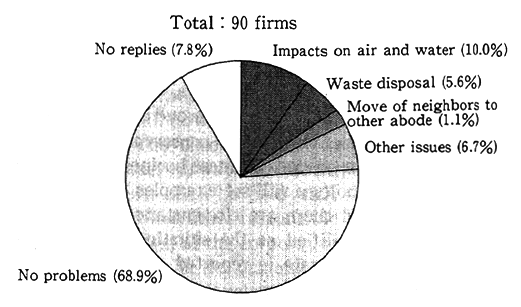
(2) Environmental Survey Prior to Location
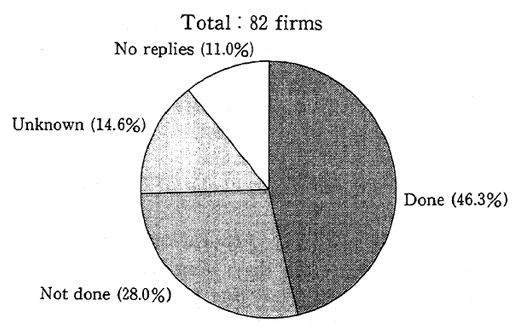
Note: Surveyed by the Environment Agency
b. Environmental Control Measures in Business Operations
In the aforementioned Survey on Corporate activities Amiable to the Environment, a question was put about the reasons for moves abroad, but few cited lenient environmental controls exercised by developing countries as a reason. Thus, it cannot be concluded that Japanese businesses abroad are not positive about environmental con- trols (Fig. 4-2-23). Actually, in a survey on Japanese businesses which had made inroads into Thailand and Malaysia, 77% of the responding corporations were familiar with the host countries' laws and regulations for environmental conservation, and 71% said that their local entity or head office had a environmental control policy and so forth. As regards the targets of the environmental control measures in force, the number of corporations which made them compatible with the host countries' standards was greatest with 61%, followed by those whose standards were higher than in the host countries with 13% and those whose standards are the same as in Japan also with 13%. Incidentally, it is necessary to note that local standards are not necessarily more lenient than the ones in Japan. Sixty-two percent of the corporations were measuring the emission of pollutants, and 66% had an in-house organiza- tion for environmental control measures, including a pollution control manager and so on, or an official in charge of environmental conserva- tion.
Fig. 4-2-23 Reasons for Business Undertakings Abroad

Note: Surveyed by the Environment Agency. The total number of responding firms is 305.
c. Issues for Promotion of Environmental Control Measures
On relations with the governments of the host countries, about 90% of the responding corporations replied that there had been no troubles, but 43% expressed concern about being involved in troubles in the future. The substance of guidance for improvements, abrupt changes in emission standards and so forth, and differences in measured values due to the use of different yardsticks for measurement were enumerated as possible troubles. Incidentally, many businesses were under the impression that other businesses--and local businesses, in particular --had troubles in environmental terms (Fig. 4-2-24).
Fig. 4-2-24 Impression about Troubles of Other Foreign Businesses on Environmental Issues
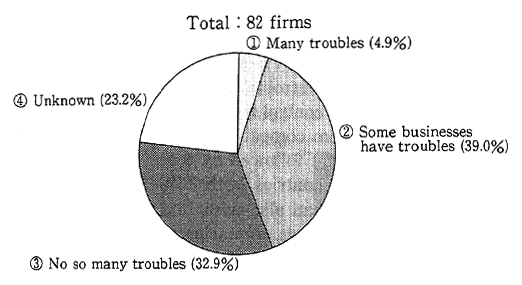
Note: Surveyed by the Environment Agency
On ties with local corporations with which they had merged, local residents and citizens' groups, 87% replied that they had never had any divergence of opinion over environmental issues, suggesting that the relations are good in broad terms. However, in the aforementioned Survey on Corporate activities Amiable to the Environment, the number of corporations which replied that "the corporation with which we have merged and so forth are less conscious about the environment" was greatest with 44%. Thus, it might be said that it is an important task to enhance the consciousness of local corporations with which Japanese businesses have merged.
When it comes to expenditures for environmental control mea- sures, the number of corporations which replied that the burden was not heavy as things now stood, but with concern about the future, was greatest with 59%-Having said that, it is conceivable that many Japanese businesses are more or less concerned about how to respond to the controls which are being reinforced, as the countries into which they have made inroads are to establish their environmental control policy. Asked about measures to further enhance their environmental mea- sures, the percentage of respondents calling for measures by the host countries came to 81% in all, such as the reinforcement of support measures by the local governments for Japanese businesses, the enhan- cement of the local people's consciousness about the environment and the upgrading of the ability of waste processing agents and other local environment-related agents (Fig. 4-2-25).
Fig. 4-2-25 Tasks on Environmental Measures
(1) Comparison of Sense of Burdening of Environment
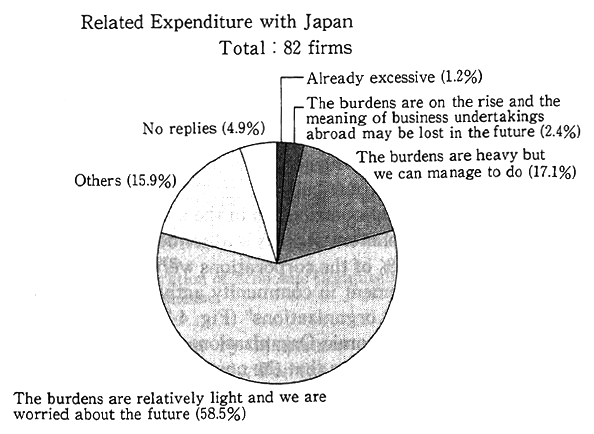
(2) The things we want for a further replenishment of environmental measures by business undertakers abroad
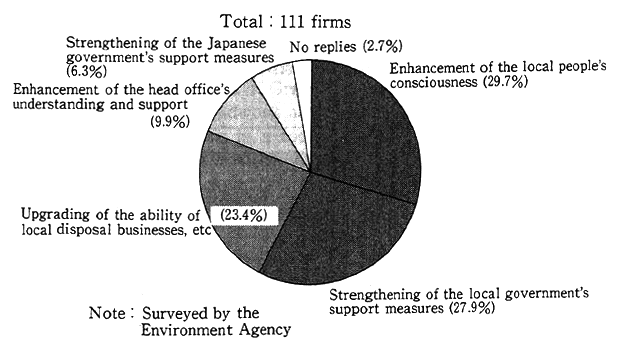
(5) Social Contributions in Environmental Sectors
It is necessary for businesses to reduce environmental loads, such as by cutting back the emission of pollutants associated with their corporate activities. That is what should be done as a matter of course. Moreover, businesses are expected to positively step up contributions to society as its members, even if the contributions have nothing to do with their corporate activities. In regard to such social contributions, the Federation of Economic Organizations (Keidanren) has advocated a "1% Club" movement, which is designed to set aside 1% of the current profit for social contributions. The total amount of corporate contribu- tions associated with all social contribution activities in fiscal 1990 came to as much as ¥549.1 billion ($4.2 billion), far behind the United States with $5.9 billion, but suggests the positive posture of Japanese businesses toward social contributions.
Activities for social contribution in the environmental sector are in progress. The Environment Agency's aforementioned questionnaire survey indicates that 67% of the corporations were developing activities in the forms of "involvement in community activities" and "support to environmental funds and organizations" (Fig. 4-2-26). The survey made by the Federation of Economic Organizations (Keidanren) on its mem- ber corporations in 1991 shows that the number of cases in which social contributions had been made was 138, and the survey conducted by the Kansai Federation of Economic Organizations (Kankeiren) also reveals that environmental conservation was taken up as a priority sector for social contributions (Fig. 4-2-27).
Fig. 4-2-26 Types of Corporate Activities Contributory to Society in Environmental Sector

Note:
1. Surveyed by the Environment Agency
2. The total number of responding firms is 356.
Fig. 4-2-27 Priority Sectors of Corporate Activities Contributory to Society
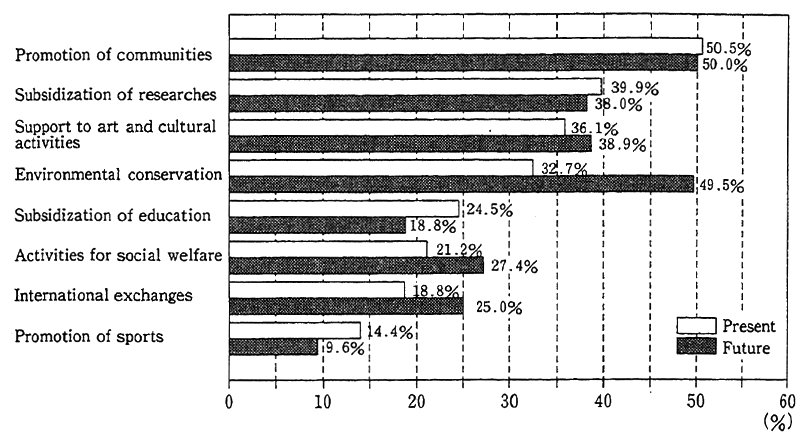
Notes: 1. Up to three replies
2. "Present" represents the sectors to which priority is given at present.
3. "Future" represents the sectors to which priority will be given in the future.
Source : Kansai Federation of Economic Organizations, Survey on Social Roles by Dusinesses
Social contributions by businesses are being upgraded, both qualitatively and quantitatively. For example, the Groundwork project in which businesses contribute to a partnership of society and citizens is one of the activities for social contributions. Historically, Groundwork activities began in Great Britain in late 1968. In 6 of the preceding section, we have seen how this system works. In Japan, too, activities under this system of partnership are drawing public attention, and Mishima City in Shizuoka Prefecture and Shiojiri City and Yamagata Village in Nagano Prefecture are designated as Japan's experimental areas. With the cooperation of Great Britain's Groundwork Trust, the Japanese version of Groundwork activities have just begun.
Social contributions in a form unique to businesses by taking advantage of not just their funds but their various other strengths as well, such as skilled workers, relations with a broad range of business partners and abundant materials, are likely to develop to a significant degree. For example, the Nature Protection Fund established by the Federation of Economic Organizations (Keidanren) in September 1992 is designed for Japanese industry to support the nature protection activ- ities of nongovernmental organizations (NGO) in developing countries and to work for personnel training through citizens' environmental groups both at home and abroad. As businesses' social contributions in the environmental sector become significant, it will become necessary for the people, local governments and the central government to develop systems and frameworks which will enable businesses to make social contributions in a smoother manner with the use of various methods, such as manpower.
(6) Playing of Greater Corporate Roles in Sustainable Society
As we have just seen, corporate approaches to environmental conservation have broadened, but in order that the efforts made by businesses may be rewarded and may become perpetual, there is the need for them to be fully appreciated and supported by product con- sumers and the people. When it comes to the assessment by consumers of businesses dealing in merchandise of an environmental conservation type, rather candid assessments are reported, as shown in Fig. 4-2-28. There is no need to say that businesses should make an appeal to consumers and so forth by means of their products and services. Moreover, they may be able to positively win the people's support by making such efforts as advertising, public-relations activities and the release of information to the public. Consumers are expected to take a greater interest in and give more support to businesses' efforts.
Fig. 4-2-28 Images of Businesses Dealing in Environmental Coservation-oriented Merchandise
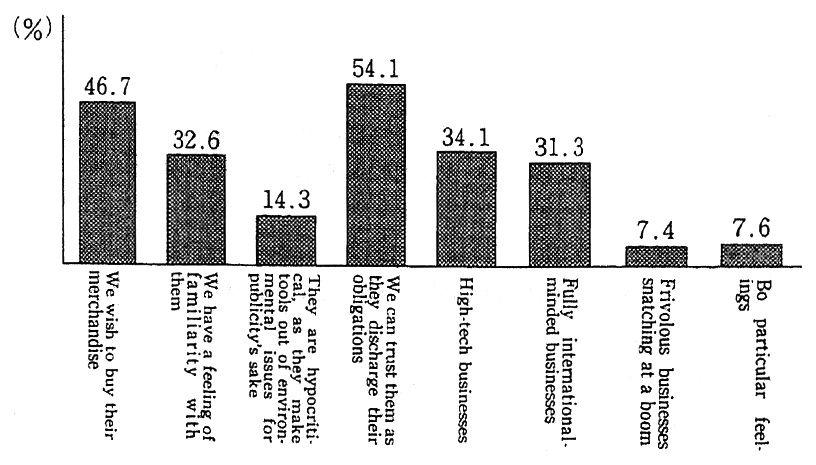
Notes: 1. Nikkei Industrial Consumption Research Institute, Environmental Problems and Consumer Behavior Patterns
2. The total number of responding firms is 957.
Individual businesses' efforts for environmental conservation amount to a rise in the expenditure, as they will not immediately produce any profit. Nonetheless, those efforts are indispensable for the survival of individual businesses. Furthermore, as we experienced when strict environmental control measures were implemented in Japan, increases in the corporate expenditure and the effect of cooling the national economy with rises in the prices of products in the long run are of such a character that they will offset an expanded economic effect which is brought about from investments by individual businesses in facilities for the prevention of environmental pollution. In macro- economic terms, economic development of environmental conservation is possible, and development of the national economy as a whole and further corporate efforts for environmental conservation are not contra- dictory by any means. It is necessary for the government to develop a framework which will make it possible to give life to corporate innova- tions and efforts and make them achievements for society as a whole, including support of the development of a smooth system of environ- mental administration.
4-2-3 Approaches by Local Governments
Environmental problems stem from the everyday activities of businesses and each one of the people in their community, so that community-encompassing approaches are indispensable for their solu- tion. When it comes to the requirement for community-encompassed approaches, hopes are pinned on local governments. The economic activities done by local governments, such as financial activities and public-works projects, are equivalent to 12% of the gross national expenditure (Fig. 4-2-29). Thus, local governments are closely tied in with the environment. Obligated to assure safety, health and welfare for residents, furthermore, local governments are expected to play an important role in the conservation of the local environment which is closely associated with residents' welfare. It might be said, therefore, that local governments are heavily responsible for the solution of environmental issues. Here, let us see the role played by local govern- ments and trends in their cooperation with other entities.
Fig. 4-2-29 Gross National Product (GNP) and Local Finance (FY 1991)
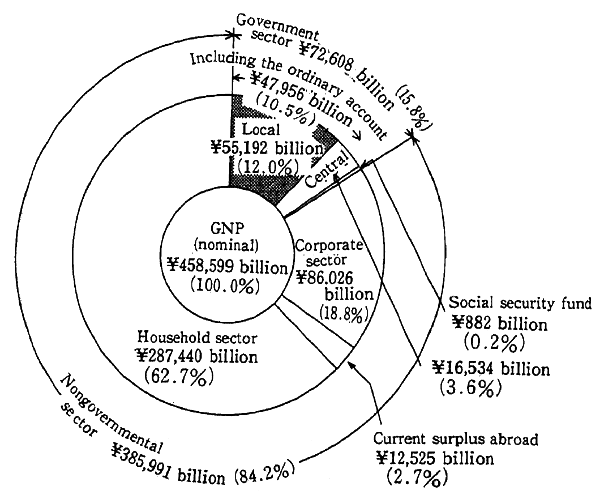
Note: Surveyed by the Ministry of Home Affairs
(1) Pioneer Roles Played by Local Governments
A review of the history of measures for environmental controls and nature protection enforced by local governments shows that they have taken the lead in their jurisdiction in response to the demands of local residents. Confronted with environmental pollution, the environ- mental degradation and nature disruption, local governments had to cope with those local issues. Since Tokyo came out with the Factory Pollution Prevention Decree in 1949, many local governments enacted a decree for the prevention of environmental pollution before the develop- ment of national legislation for environmental controls. As is discernible from the conclusion by Shimane Prefecture of agreements for the prevention of pollution with local factories in 1952, there appeared many pioneering approaches with many local governments subsequently com- jug on the track of Shimane Prefecture. For nature protection, on the other hand, the practice of designating prefectural natural parks and so forth under a decree became brisk in the 1955-64 period. In 1970, Hokkaido enacted the Nature Protection Decree by which it would designate areas the natural environment which had to be maintained in good condition and the prefecture governors would provide counsel on inappropriate corporate acts and so on. As is discernible from this case, measures were implemented at various places to comprehensively wrestle with nature protection. Viewed from administrative organiza- tion, it became a practice to establish divisions and departments special- izing in environmental pollution in the 1955-64 period, thus starting full-fledged approaches to the prevention of pollution under specialized organizations (Fig. 4-2-30).
Fig. 4-2-30 Prefectural Departments/Divisions Taking Exclusive Charge of Pollution and Enactment of Pollution Prevention Decrees (Aggregate total)

Note: Surveyed by the Ministry of Home Affairs
In the assessment of environmental impacts in the 1975-84 period, Kawasaki City and other local governments went ahead of the State in the development of institutions to pioneer new approaches, through decrees and standing operation procedures for the assessment of envi- ronmental impacts.
Later, the State enacted the Basic Law for Environmental Con- trol. It also enacted the Natural Environment Conservation Law in 1973 after the streamlining of pollution-related laws at the so-called Pollution-oriented Diet session in 1970. With the enactment of those laws as momentum, institutional frameworks were prepared to make effective use of the vitality of local governments and unique approaches responsive to the natural and social conditions of their jurisdictions (Table 4-2-2). Beside the development of national and local institutions, efforts were made by local entrepreneurs and citizens for the prevention of environmental pollution and conservation of the natural environment, with the result that the environmental control measures which had started with the pioneering approaches of local governments taking root, producing significant effects on efforts to overcome a rapidly intensifying industrial pollution and conserve the natural environment.
Table 4-2-2 Main Lines of Administrative Work by Local Governments on Environmental Conservation
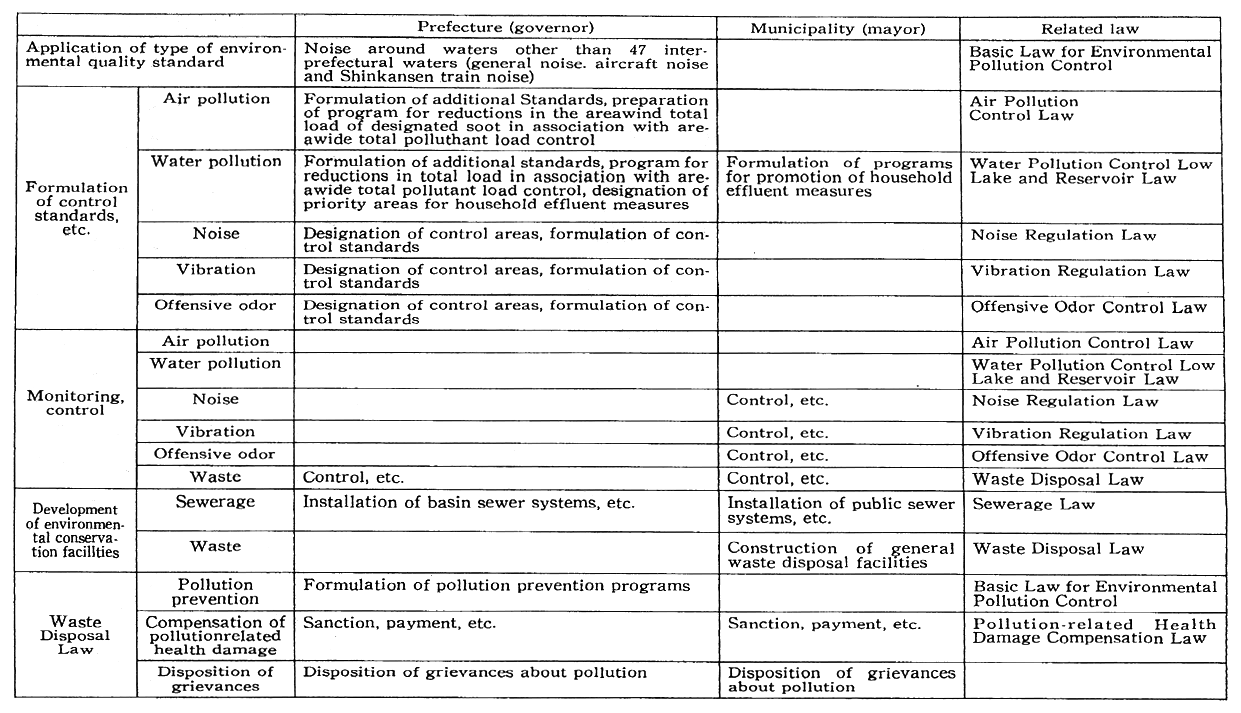
Note:Surveyed by the Environment Agency
(2) Local Governments Sharing New Roles
In recent years, there have often cropped up problems which cannot be coped with merely by methods to combat the conventional type of pollution, or methods like symptomatic treatment in which facilities and acts which produce significant loads on the environment are enumerated and controlled, or problems which are not immediately tied in with the protection of health but give rise to a significant degradation of the environment. The typical examples are problems on the global environment and environmental pollution of an urban and household type. When it comes to those questions, the causes stem from economic activities and the causative factors are extremely diverse in many cases, so that local governments are requested to come out with new responses.
Some local governments have begun pioneering approaches to those new problems. Particularly, the local decree reflects local auton- omy in the Constitution and is independent in contrast to national legislation. The enactment is empowered only by local governments. When the legal benefits which are realizable by calling for residents to make efforts of their own accord, or invoking penal provisions in cases where an inappropriate act is detected, and with a general consensus of the residents, the decree is an indispensable means. With attention focused on decrees, let us see new moves in environmental control measures implemented by local governments.
With respect to dispersed empty cans, the State has implemented measures under various laws and other measures. As we have seen in 8, Section 1, Chapter 1, no conspicuous improvements are observed in their dispersion. Given this picture, Kitano Town in Fukuoka Prefecture and Wakayama City enacted a decree under which penal provisions would be invoked for the act of carelessly throwing things away in 1992. Under Kitano Town's decree, persons who throw away empty cans, cigarette butts and so forth, be they residents or travelers, will have to pay a fine not exceeding Y30,O0O. Entrepreneurs who have installed automatic vending machines are demanded to install boxes for the recovery of empty cans and, if they fail to report about their installation, will be fined.. As regards penal provisions for littering provisions with penal clauses are incorporated in the Waste Disposal and Public Cleaning Law (Waste Disposal Law), the Road Traffic Law and so on to control illegal littering. Provisions which call for cleaning and collecting wastes, in- cluding empty cans, to keep private land clean are also contained in the Waste Disposal Law. With this in mind, the local decrees are designed to actively make the environment beautiful. There are cases where punishment will be immcdiate if trash is cast away in designated areas. In addition to Kitano Town and so forth, Mogami Town in Yamagata Prefecture and 22 municipalities in the Fukuoka urban sphere are also working to enact a similar decree. With problems difficult to deal with across the board such as the throwing away of empty cans, there are moves to deal in conformity with local features and under a local agreement and responsibility.
In 1992, Shiga Prefecture enacted the Decree for Conservation of Ditch Reed Stocks Around Lake Biwa in Shiga Prefecture for the conservation of ecosystems in the lake. The stocks of ditch reeds are important for the habitation and propagation of fish and birds and useful for the prevention of lakeside erosion and the conservation of the water quality. They are also a useful reSource, such as for the produc- tion of reed screens. This decree is designed to work for the environmen- tal conservation of Lake Biwa by actively conserving reed stocks in and around the lake and giving life to their many-sided functions. In plain language, the places where the reed stocks grow and those where they should be propagated are designated as "ditch reed stock conservation areas" for their conservation and propagation, such as by making it necessary to get a permission for any alteration. The idea is to promote measures not just with projects by the prefecture and municipalities, including the cutting down of ditch reeds and so forth, plantation and cleaning, but with the active involvement and cooperation of local entrepreneurs and residents. This decree is an all-inclusive attempt to step up involvement and to enhance people's consciousness through participation.
Bisei Town in Okayama Prefecture also enacted a decree which incorporates standards on the installation of outdoor lighting facilities so that the light of electric lamps may not be projected above the horizon in attempts to conserve the beautiful star-studded sky and create a favorable environment for astronomical observation and so forth. The decree of Shiga Prefecture and that of Bisei Town might. be described as examples in which attention is focused on unique environ- mental reSources and their conservation is brought up to a point where local rules are set for their conservation.
Beside the enactment and enforcement of decrees, local govern- ments are availing themselves of various contrivances and making efforts. There are signs of an increase in the necessary budget, and when it comes strictly to the measures and projects done by prefectures of their own accord without any grant-in-aid from the State, the budgets reached about ¥400 billion in fiscal 1991, as shown in Fig. 4-2-31.
Fig. 4-2-31 Secular Changes in Total Amount of Budgets for Environmental Conservation Measures
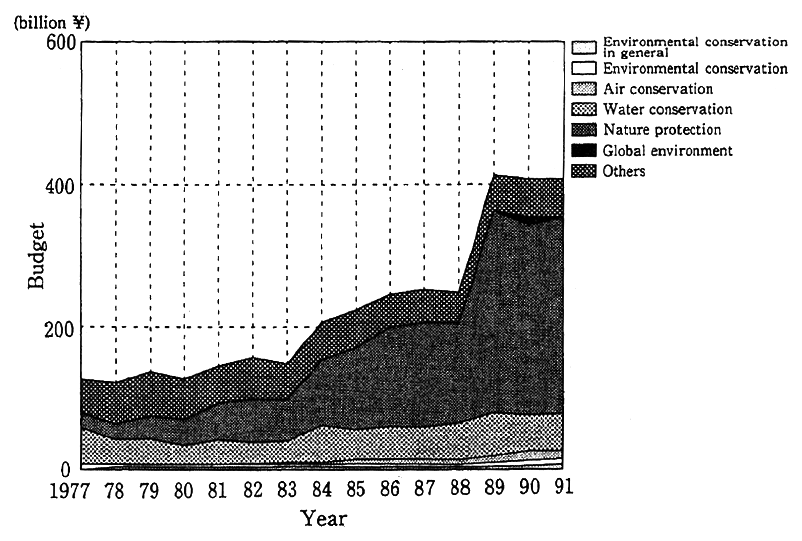
Notes: 1. Surveyed by the Environment Agency
2. Total amount of budgets earmarked for independent measures for environmental conservation in the prefectures and administrative ordinance-designated cities.
Incidentally, the top-priority measures and projects done by prefectures and administrative ordinance-designated cities in fiscal 1992 are given in Table 4-2-3. Many of them are full of diversity and ingenious. Of the total budgetary amount for those top-priority measures, 20.3% came from the State and local outlays accounted for 79.7%.
Table 4-2-3 Examples of Priority Environmental Conservation Measures by Local Governments (FY 1992)
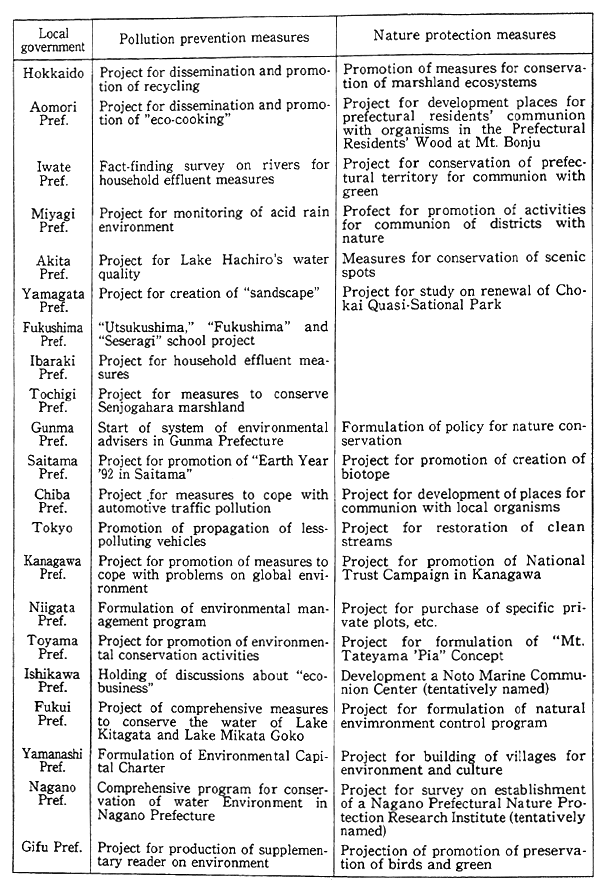
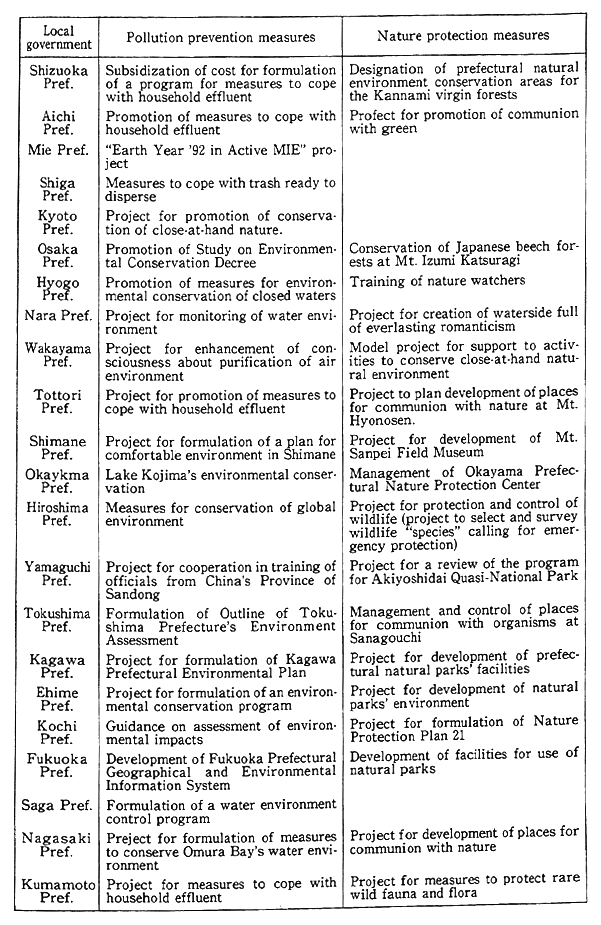
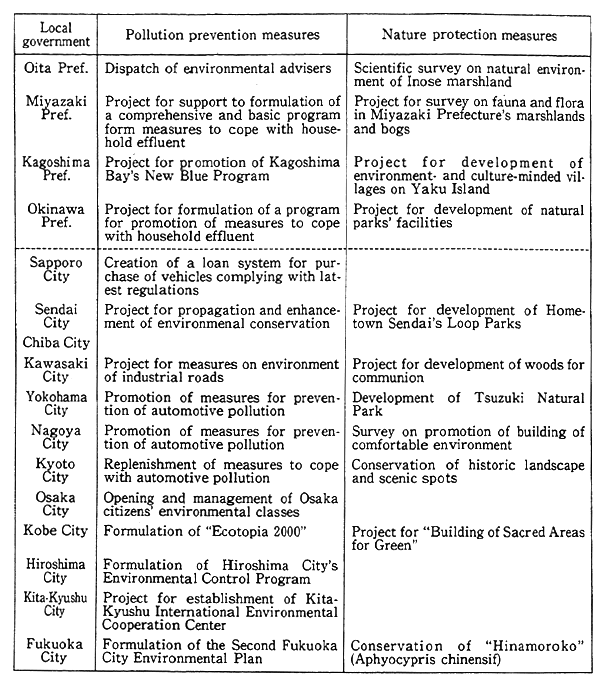
Budgets for FY 1992
Measures for pollution prevention; ¥5,456 million (including ¥73O million for the State and ¥4,726 million for the prefectures and municipalities)
Measures for nature protection: ¥25,360 million (including ¥7,926 million for the State and ¥22,890 million for the prefectures and municipalities)
Total; ¥30,816 million (including ¥7,926 million for the State and ¥22,890 million for the prefectures and municipalities)
(The measures tied in with pollution prevention include those both for pollution prevention and nature..)
Note : Surveyed by the Environment Agency
(3) Expanding Measures for Conservation of the Global Environment
Of the measures and so forth enumerated in Table 4-2-3, some are associated with the global environment. Thus, conservation of the global environment has become one of the ssues with which local governments grapple in addition to conventional environmental control measures and nature protection. Japan's economic strength is so formidable that there are many local governments whose economic power compares with a single foreign country's GDP. That is why their impacts on the global environment are significant (Fig. 4-2-32). Besides, local governments are internationally expected to play a role of their own in building a local environment amiable to the global environment.
Fig. 4-2-32 Comparison of Gross Product of Prefectures with GDP of Major Countries
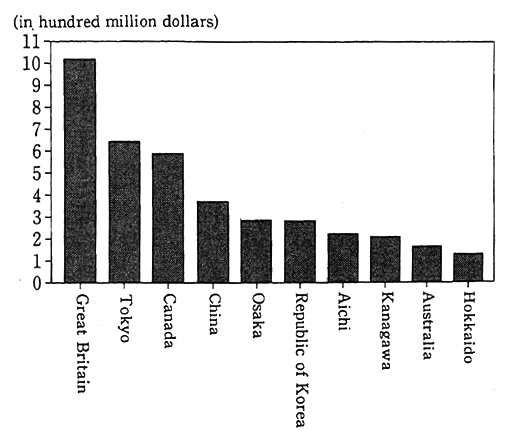
Notes: 1. Economic Planning Agency, Prefectural Economic Computation Yearbook, 1992 ; Bank of Japan, Yearbook of Foreign Economic Statistics, 1991 edition
2. The data of the foreign countries are for 1991 and those of the prefectures are FY 1989.
3. The exchange rate is ¥122 to the dollar
At the Earth Summit held with the participation of about 180 countries around the world in June 1992, a broad range of issues on environment and development was debated, and the results were incor- porated in Agenda 21. the action program for the 21st century. The roles which are to be played by local governments are enumerated in Chapter 28. It is stated in Agenda 21 that "by 1996, most local authorities in each country should have undertaken a consultative process with their populations and achieved a consensus on 'a local Agenda 21' for the community." The call for the formulation of Local Agenda 21, an action program at a local level, is something which was studied in the prepara- tory phase for the Earth Summit In the Berlin Declaration adopted at the specialists' meeting on the promotion of local governments held in Berlin in February 1992 with the participation of nongovernmental organizations (NGO), the formulation of Local Agenda 21 was proposed. In the Curitiba Commitment of the World Cities Forum held in the Brazilian city of Curitiba immediately before the Earth Summit, the formulation policy is specified. It might be said that local governments are internationally called to display their leadership.
Here, let us see the approaches made by local governments in Japan to problems of the global environment. The survey performed by the Environment Agency on the nation's 47 prefectures and 12 adminis- trative ordinance-designated cities in October 1992, indicates that they are wrestling with conservation of the global environment. According to the survey, Kawasaki City and Kumamoto Prefecture have enacted a basic environmental decree for conservation of the global environment and some other local governments are studying the advisability of coming out with a similar decree. The formation of plans, policies and guidelines in a perspective of conserving the global environment is wrestled with by many local governments. Tokyo and other cities have already formulated an action program for conservation of the global environment. A number of prefectures are trying to incorporate ideals and measures for conservation of the global environment in the environ- mental control program designed to make clear the way the local environment ought to be and comprehensively carry out various mea- sures for its realization.
As for organizations to deal with problems on the global environ- ment, 41 local governments, or nearly 70% of all local governments, have established an in-house organization for promotion, and Aichi Prefecture and 10 other local governments have set up an outside organization for promotion.
The tangible measures and projects for conservation of the global environment include town or community building with the global envi- ronment taken into account, measures to support and guide life style and the approaches made by residents and businesses, surveys and researches on conservation of the global environment and international environmental cooperation, among others. The number of those cases by type of activity is given in Fig. 4-2-33.
Fig. 4-2-33 Measures for Coservation of Global Environment by Local Governments (Prefectures and Administrative Ordinance-designated Cities)
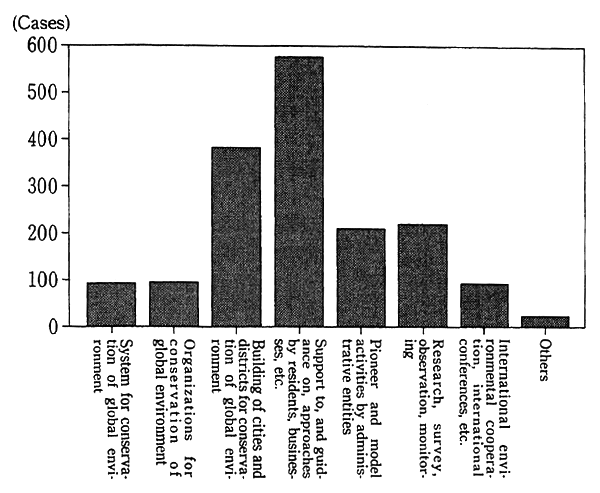
Note Surveyed by the Environment Agency
Let us take Kita-Kyushu City as an example of international environmental cooperation by a local government. Making effective use of the experiences and technologies it accumulated in trying overcome environmental pollution, the city has established an environmental study course in the Kita-Kyushu International Techno-Cooperative Associa- tion with capital laid out by the city and its industry, accepting many foreign trainees in a project of the Japan International Cooperation Agency (JICA). At the same time, Kita-Kyushu City is striving for technical cooperation, working for the transfer of technologies for the prevention of environmental pollution, such as with the dispatch of governmental and nongovernmental specialists to developing countries. In the acceptance of trainees and technical cooperation, not only does the city government plays its role, but universities and businesses offer places for on-the-job training and citizens offer home stays for trainees, suggesting that administrative authorities, businesses and citizens give life to their own capability and characteristics in contributing to inter- national environmental cooperation. Those approaches encompassing the whole municipal community was praised at the Earth Summit, and Kita-Kyushu City became a subject for the United Nations' commenda- tion of local governments.
Globally, there have appeared many local governments which locally strive for conservation of the global environment. Along with Kita-Kyushu, the United Nations honored 12 cities around the world: Ankara (Turkey), Austin (U.S.), Bulawayo (Zimbabwe), Cairo (Egypt), Curitiba (Brazil), Leicester (Great Britain), Mexico City (Mexico), Saarbr .uuml; cken (Germany), Storstom province (Denmark), Sadbury (Canada) and Surabaya (Indonesia).
There have started moves for local governments to cooperate one another in building an international network. The International Council for Local Environmental Initiatives (ICLEI) was established at the World Conference for a Sustainable Future held by the United Nations in September 1990 with the participation of upwards of 200 local governments in 42 countries to enable local entities to get together in dearing with global problems. Environmental questions today have come to a point where concrete actions are taken to have the social and economic systems of the entire world produce less loads on the environ- ment. Though they often made local responses to questions peculiar to their own jurisdiction, local governments are now being assigned the task of dealing with problems common to the world. It is significant for local governments around the world to work for international exchanges and step up cooperation. At present, the ICLEL is carrying out projects, such as the formulation of a program for reductions in carbon dioxide emissions and a program for the building of a database for autonomous environmental entities. As of the end of March 1993, Yamanashi Prefecture and Kita-Kyushu City were ICLEI members, and other local governments are studying the advisability of their participa- tion. This international institution is looking for a local government which would be willing to serve as its secretariat for the Asian-Pacific region, and some local governments in Japan have filed applications.
(4) Understanding and Cooperation Necessary for Further efforts by Local Governments
As we have just seen, it is indispensable that local governments activily cooperate with various other entities and make efforts for the building of a society with less loads on the environment. Nonetheless, local governments have a wide variety of difficulties in their measures and projects. According to the survey performed by the Local Autono- mous Bodies' Association on problems with conservation of the global environment, for example, the maintenance of financial resources, infor- mation and technology or responses by related businesses and the maintenance of specialists are enumerated. There is the need for the cooperation of a broad segment of related persons in trying to overcome the difficulties which confront local governments.
When it comes to relations with the State, many environmental conservation-related authorities have been delegated to local govern- ments, appropriate coordination between the State and local govern- ments is indispensable to work for the promotion of environmental administration. In terms of characteristics, environment issues are different, depending on the district, and there are cases in which there are calls for complex measures. In the enforcement of the central government's measures in various sectors in tune with actual local conditions, local governments are routinely assigned a significant role. For local governments to step up environmental conservation measures, on the other hand, there is the need for the active cooperation of the State under whose jurisdiction the building of institutions for the nation as a whole is placed.
As regards relations with residents, it is indispensable for local governments, whose primary mission is to carry out administration for the benefit of residents, to secure the cooperation of residents in envi- ronmental conservation. Residents would not be able to fulfill their responsibility for environmental conservation without the assistance of their local government which is organized by the representatives they have chosen. When it comes to relations with businesses, an evolution of local environmental measures could not be hoped for without the cooperation of businesses, which have a significant impact on the local economy and society. In the case of Japan, fortunately, local govern- ments and businesses have historically worked together in enforcing environmental control measures. It is to be hoped that good cooperative relations will continue between them.
In the Bill for the Basic Environmental Law presented to the Diet in March 1993, it is stipulated that relations between the State and local governments shall be continued as they are, and that local governments shall play a positive environmental conservation role in formulating and carrying out measures which conform to the State's measures and other necessary environmental conservation measures in conformity of their actual local conditions. Moreover, local governments are expected to step up measures for conservation of the global environment. The bill expressly described the role of local governments as important in stepping up conservation of the global environment and so on. With this in mind, it is stipulated that the State shall strive to take measures necessary for the promotion of activities for international cooperation in global-environmental conservation and other measures enforced by local governments.
It is strongly hoped that the position of local governments will be appropriately understood, and they will be cooperated with, as they have become members of an environment conservation network which now stretches from inside the country to outside.
4-2-4 Government
Environmental issues are described as those which cannot be solved by the market economy as they are typical example 9 of so-called market failures. For this reason, the government's role is indispensable.
The government has played a wide variety of functions to step up environmental conservation for the nation as a whole. Historically, environmental pollution was controlled under the Factories Law and so forth in the prewar years. In the 1955-65 period, the enactment of laws for the regulation of environmental pollution began. Particularly under the Basic Law for Environmental Control in 1967 and the Natural Environment Conservation Law in 1972, the government began system- atic environmental control measures with all its institutions united as one body. The government formulated environmental quality standards to show the targets of environmental control measures and the basic direction of natural environment conservation measures in the basic policy and worked out plans for a system of legislation for environmen- tal conservation. The government has since played the roles assigned to it, such as the legitimate implementation of controls and other measures under that system, the paying of full consideration to the environment in its own behavior, the promotion as public works projects of develop- ing facilities and services contributory to environmental conservation, or those projects which cannot be adequately carried out in free private activities, and the promotion of basic surveys, researches and technical development, among others. In regard to pollution-related disputes and damage compensation, the solution of which is privately difficult, the government has worked for responses to grievances about environmen- tal pollution, conciliation by prefectures and the Mediation Committee on Environmental Pollution, Etc.. and the prompt and fair relief of suffers from environmental pollution under an administrative compen- sation system based on the civil obligations of polluters. It is also yet another important function of the government to enhance the people's consciousness in the dissemination of environmental information and environmental education and encouraged the private sector to wrestle with environmental issues on their own accord. Trends in the budget for the measures the government carries out for environmental conserva- tion are shown in Fig. 4-2-34. In recent years, the share in the govern- ment budget as a whole has leveled off, but there are signs of a rise in the total amount (see Section 1, Chapter 1, Part 2, for the breakdown).
Fig. 4-2-34 Trends in Environment-related National Budget
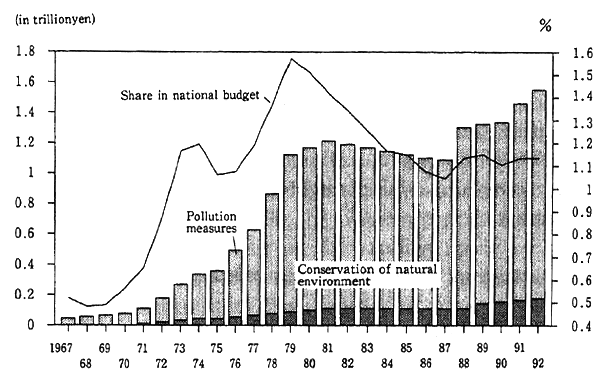
Source: Environment Agency
In order to cope with today's conditions, such as the temporal and spatial expansion of environmental problems and the growing complex- ity of causative factors, there are calls in various sectors for a further enhancement of the government's efforts, as we have seen in 1 through 3 of this section. Here, let us take up some of the government's roles, the importance of which is rising.
(1) Presentation of Ideals and Desirable Environment
The blessings brought about by the environment are diverse. So are the ways in which people use it, as it is utilized by extremely large numbers of people in different positions. For this reason, it is important to adjust those diverse ways so that they may become reasonable ones. As regards environmental quality standards, they are formulated as those for an environment the maintenance of which is desirable to work for man's health and conservation of the living environment. It is stipulated that emission controls and various other measures shall be implemented for maintenance of those standards. Then there are those which specify the way the environment ought to be, depending on the purposes and its uses, such as the categorization of environmental quality standards associated with living-environment and water and those tied in with noise. As regards living-environment items on water, for example, categorization is made according to purposes for the use of the environment, such as the exploration of nature's scenery and tap water service systems, and to types of subjects, such as tap water operation methods and fisheries. As we have seen in Chapter 3, the blessings expected from the environment are not confined merely to the protec- tion of the present generations' health, and there is the need to take account of future generations. When it is taken into account that the environment does not have national boundaries, the environmental blessings are something which ought to be broadly shared around the Earth as a whole.
(2) Promotion of Systematic Approaches
As we have discussed in Chapter 2, the many environmental problems with which we are confronted, such as global warming and increases in the disposal of wastes, are caused by various socioeconomic activities with are broadly tied in with one another. As we have seen various examples in Chapter 1, there must be assurances for the solution of those issues reqviring each social entity to wrestle with diverse measures on the basis of common recognition and in a medium and long-range perspective. For this, it is necessary to build the people's consensus on a desirable image of the environment, which should be put into reality, laying before the people the basic guideline and plan for environmental policy. By so doing, there is the need to effectively encourage all sorts of entities as a whole to grapple with environmental measures in a voluntary and concerted manner. It is also important to fully put the perspective of environmental conservation into the realm of various policies associated with environmental problems, including economic policy. From this perspective, it was made the basic direction of policy management to build economic structure of domestic-demand which is in harmony with the environment, for example, in the Five- Year Plan for a Major Power in Terms of Living, a long-term economic program, approved by the Cabinet in June 1992. The plan is designed to work for improvements in the global environment, and the structure and environment of an economic society in harmony with the environment, and a simple life style.
When it comes to foreign countries, there are nations which are working for the comprehensive promotion of national plans for the environment. The Government of the Netherlands prepared and released the National Environmental Policy Programme (NEPP) in 1989. This plan incorporates the government's policy measures on all sorts of environmental issues both at home and abroad. While foresee- ing the period which extends to 2010, it sets the last year of the plan period at 1994, and casts light on policy ideals and targets and formu- lates detailed policy measures which encompass all sectors including the reinforcement of various controls, research and technical development, financial investments and loans, revision of the tax system, and dissemi- nation and enhancement activities for the people. In 1990, moreover, the Government of the Netherlands came out with NEPP-Plus in which those policy measures in the program that would have to be promptly carried out were specified. In 1990, the Government of Canada formulat- ed the Green Plan on the basis of the studies made by councils, the people's hearings and the views and so forth of various organizations. The plan specifies the targets that should be achieved and the policy measures the government should take in the 1990s in all sectors includ- ing the conservation of air, water and soil, of recyclable resources, of ecosystems and of the global environment, among others. Incidentally, the government makes it a rule to follow up on the plan every year so that changes in the policy priorities may be appropriately reflected. In the seven industrial democracies (G-7) which are members of the eco- nomic summit, environmental plans are worked out at government level with the exception of the United States (Table 4-2-4).
In Japan, too, provisions are incorporated in the Bill for the Basic Environmental Law, presented to the 126th Session of the Diet in March 1993, to the effect that the government should draw a basic environmen- tal program which would include the outline of comprehensive and long-term policy measures for environmental conservation, among others.
Table 4-2-4 Environmental Plans by Government of Countries Participating in G-7 Summit
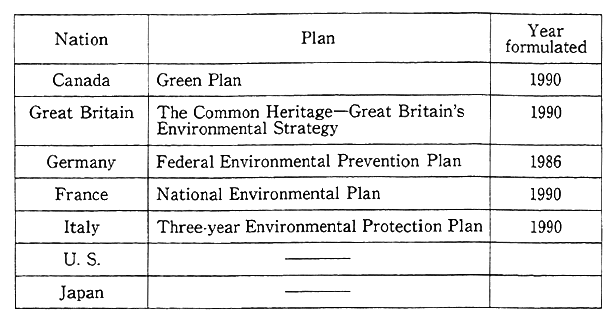
Note : Surveyed by the Environment Agency